Castello Ursino
Castello Ursino (Sicilian: Casteddu Ursinu, lit. 'Bear Castle'), also known as Castello Svevo di Catania,[1] is a castle in Catania, Sicily, southern Italy. It was built in the 13th century as a royal castle of the Kingdom of Sicily, and is mostly known for its role in the Sicilian Vespers, when it became the seat of the Sicilian Parliament. The castle is in good condition today, and it is open to the public as a museum.
| Ursino Castle | |
|---|---|
Castello Ursino | |
| Catania, Sicily, Italy | |
 View of the castle | |
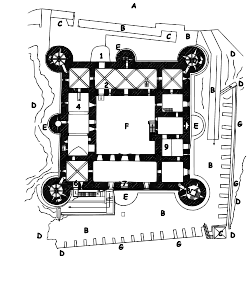 Plan of the castle's first floor | |
| Coordinates | 37°29′56″N 15°5′5″E |
| Type | Castle |
| Site information | |
| Open to the public | Yes |
| Condition | Intact |
| Site history | |
| Built | 1239–1250 |
| In use | 13th–19th centuries |
| Events | Sicilian Vespers |
History
Construction
Castello Ursino was built between 1239 and 1250, as one of the royal castles of Emperor Frederick II, King of Sicily, closing a chapter on the turbulent time in Sicily that followed the death of his predessor, William II.[2] Local lords had attempted to assert independence, and in 1220 Frederick II had ordered the destruction of all non-royal castles in Sicily.[2] Castello Ursino was built to stress royal power as well as for the defence of the capital,[2] and was considered impregnable at the time.
Sicilian Vespers
In 1295, during the Sicilian Vespers, the Parliament which declared deposed James II of Aragon as King of Sicily, replacing him with Frederick III, was held here. The following year it was captured by Robert of Anjou but was later again in Aragonese hands.
Royal seat
King Frederick III resided in the castle, as well as his successors Peter II, Louis, Frederick IV and Maria. Here the latter was kidnapped by Guglielmo Raimondo III Moncada to avoid her marriage with Gian Galeazzo Visconti (1392). King Martin I held also his court in the castle.
Decline
After the move of the capital away from Catania and the appearance of powder weapons, the castle lost its military role and was used as a prison. It is one of the few buildings in Catania to have survived the earthquake of 1693.
When the castle was first built, it was on a cliff looking out to sea, however as the result of volcanic eruptions, and earthquakes, it is now a kilometre inland. The former moat too in the 17th century was filled with lava from an eruption by Mount Etna. Its present location, surrounded by streets and shops in a typical Catania piazza, may strike some visitors as unusual.
Present day
The castle was acquired by the city of Catania in 1932, and it was restored. The Museo civico opened in the restored castle on 20 October 1934. Today, the museum houses artifacts and artwork from the castle as well as the greater geographical area. These items date from the Classical era onward, representing the diverse influences throughout Sicilian history.[1] Frequently, the castle hosts also temporary exhibitions or artistic events (theatrical representations and concerts). It also possible to use the historical site to celebrate a civilian union.
Further restoration work was carried out in November 2009.
Layout
The castle has a rectangular plan, with a large circular tower at each corner and an open-air inner court
Museum layout
Salone d'Armi
This houses the museum's ticket office as well as Jewish inscriptions and inscriptions from the medieval senate-house where the decision was taken to expel the city's Jewish population in 1492, including a copy of the Julia Fiorentina inscription from the Louvre. It also houses a medieval keystone, a 16th century cannon, parts of an ancient Roman mosaic showing the months, a 16th century inscription mentioning a castellan from Toledo and a statue of Ignazio Paternò Castello Principe di Biscari, by Antonio Calì, displayed with a copy of his book Viaggio per le Antichità della Sicilia.
The room is, however, named after its large collection of weapons.
.jpg.webp) Jewish inscriptions
Jewish inscriptions Mosaic
Mosaic Inscription on the explusion of the Jews in 1492
Inscription on the explusion of the Jews in 1492
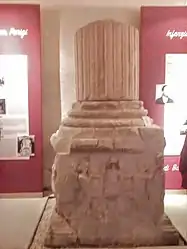
Sala di raccordo nord
This room and those following it display finds from the city's Roman theatre, including a huge headless statue, a torso of Hermes and a plinth found by Biscari in 1770 showing a trophy crowned by two Victories and two barbarian prisoners on its sides.
Torre delle Bandiere
This houses fragments of Roman mosaic, statue of Hercules and a plaster copy of Costanza d'Aragona's sarcophagus.
Salone delle scuderie

The main works exhibited here include:
- a mosaic of putti from the Terme Achilliane, showing them inviting you to enjoy your stay in the baths ("Vtere Feliciter")
- fragment of a frieze showing Apollo and Artemis in a gigantomachy, 3rd century AD
- male torso, dedicated to Jupiter, found near the monastery of Sant'Agostino by principe Biscari in 1737.
- statue of Hercules in a lionskin just after killing the Nemean Lion
- statue of Hercules resting, Farnese Hercules type, holding one of the apples of the Hesperides
- plinth with dolphins
.jpg.webp) Torso of Jupiter
Torso of Jupiter.jpg.webp) Frieze of a gigantomachy
Frieze of a gigantomachy Bellerophon, 2nd century AD
Bellerophon, 2nd century AD._Castello_ursino%252C_Catania_-_Photo_by_Giovanni_Dall'Orto%252C_October_28_2016.jpg.webp) Hercules in Lionskin, 2nd century AD
Hercules in Lionskin, 2nd century AD Apollo with a Cithara, 1st century AD
Apollo with a Cithara, 1st century AD

Sala
This houses displays of clay statues of subjects such as Aphrodite, a small dog fighting a cockerel, a nymph on a rock and a prehistoric head. Particularly notable is a colossal ram, whilst the most important work in the room is a fragment of a cavalryman, probably from a historiated column, found near porta Carlo V.
Torre del Sale
Named after its previous use as a storehouse for salt, it now houses a mosaic showing a head, thought to be an allegory for Africa, and a bust of an Egyptian woman.
Sala di San Giorgio / Sala della Cappella
This displays around 2000 bronze figurines, of which 1600 are from the Benedettini collection and the rest from the Biscari collection. They date to the Archaic, Siceliot, Greek, Etruscan-Italic and Hellenistic eras. It also houses a 420 BC marble relief of Demeter and Kore found on Montevergine hill in 1930 and several Greek vases such as the red-figure Crater with Perseus and Medusa from excavations in Camarina.
_-_Photo_by_Giovanni_Dall'Orto%252C_October_28_2106.jpg.webp)
 Figurines
Figurines Bust of Demeter, 5th century BC
Bust of Demeter, 5th century BC%252C_conservato_al_castello_ursino.jpg.webp) Carcaci cippus
Carcaci cippus
Other rooms
These house inscriptions and statues, together forming the permanent "Voci di Pietra" display:
 Inscription of Aurelius Samohil
Inscription of Aurelius Samohil Attic rhyton
Attic rhyton Attic crater with a symposium scene
Attic crater with a symposium scene Black-figure Attic lekythos
Black-figure Attic lekythos_-_Catania%252C_Castello_Ursino_-_Photo_by_Giovanni_Dall'Orto%252C_October_28_2016.jpg.webp) Polyphemus and Ulysses, 2nd century AD
Polyphemus and Ulysses, 2nd century AD Wrestlers, 2nd century AD
Wrestlers, 2nd century AD
First Floor
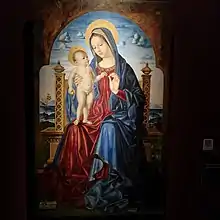
Sala
This houses:
- two tomb reliefs (one for a 16th century recipient of the Order of the Golden Fleece and the other of a sleeping figure)
- Byzantine icons
- a Limoges enamel plaque of the crucifixion
- a 'smalto' of The Virgin in Glory
- Portrait of a Gentleman by El Greco (recently restored using funds from OperaTua)
- a 15th century painting of Madonna with Saint Lucy and Saint John
- parts of a polyptych by Antonello de Saliba from Santa Maria di Gesù church: Madonna and Child, St Anthony, St Francis of Assisi, Resurrection
- St Onufrius by Bernazzano.
- 17th century chess set from the Benedettini
- Last Supper by Luis de Morales.
%252C_castello_ursino.jpg.webp)
Salone dei Parlamenti
This mainly houses 17th and 18th century works, including masterpieces by Matthias Stomer from the collection donated to the city by Giovan Battista Finocchiaro in 1826 such as Death of Cato, Crucifixion of St Peter, Suicide of Seneca and Christ Mocked. It also displays works by Pietro Novelli such as St Christopher, St John the Baptist, Madonna and Child with St Louis of France and The Good Samaritan. Also notable are:
- the only surviving copy of Caravaggio's Nativity with St. Francis and St. Lawrence, the original of which was stolen by the Mafia and has never been recovered - the copy was produced in 1627 by Don Gaspare Orioles da Paolo Geraci.
- Christ at the Column by Mario Minniti
- Penitent Mary Magdalene, school of Giovanni Lanfranco
- St Luke Painting the Virgin Mary by Mattia Preti
- St Catherine in Ecstacy, previously attributed to Giulio Cesare Procaccini and later to Pier Francesco Mazzucchelli.
- Prophet, St Francis with a Crucifix and Lament over the Dead Christ by Jusepe de Ribeira and his school
- Mary Magdalene by Andrea Vaccaro
- Three Kings by Simone de Wobreck
- St Januarius attributed to Francesco Solimena

 Matthias Stomer - Death of Cato
Matthias Stomer - Death of Cato_-_Foto_Giovanni_Dall'Orto%252C_2-Oct-2007a.jpg.webp) Matthias Stomer, Christ Mocked
Matthias Stomer, Christ Mocked%252C_castello_ursino.jpg.webp) Morazzone - Ecstacy of Saint Catherine of Siena
Morazzone - Ecstacy of Saint Catherine of Siena%252C_castello_ursino_.jpg.webp) Mario Minniti - Christ at the Column
Mario Minniti - Christ at the Column%252C_castello_ursino.jpg.webp) Mattia Preti - Saint Luke as a Painter
Mattia Preti - Saint Luke as a Painter
Sala
This room houses 18th century works:
- Coronation of Saint Agatha, Death of Saint Joseph and Saint Francesco Caracciolo, oil sketches by Marcello Leopardi
- Martyrdom of Saint Agatha, oil sketch by Mariano Rossi.
- Still Life with Fruit and a Landscape and Still Life with Fruit and a Fountain by Aniello Ascione.
- Landscape with Ruins, anonymous west Italian painter, one of five paintings from Villa Scabrosa; a pair withNaval Battle
- Woman Selling Fish by Giuseppe Bonino (1760)
- Kneeling Aphrodite, statue by a central Italian artist in classical style
- Mary Magdalene, attributed to Guglielmo Borremans
- St Agatha Before Quintianus, wax sculpture
- St Agatha Crowned in Prison, wax sculpture
- door sculpture in the style of the Gagini family
- Portrait of Prior Placido Scammacca, shown holding an ancient Greek vase
- Birth of Venus, small painting by Michele Rocca
- Birth of Adonis, small painting Michele Rocca

%252C_castello_ursino.jpg.webp) Giuseppe Bonino - Woman Selling Fish
Giuseppe Bonino - Woman Selling Fish%252C_castello_ursino.jpg.webp) Anon. - Landscape with Ruins
Anon. - Landscape with Ruins%252C_castello_ursino.jpg.webp) Possibly Guglielmo Borremans - Mary Magdalene
Possibly Guglielmo Borremans - Mary Magdalene
Sala Michele Rapisardi
As its name suggests this room mainly displays paintings by Michele Rapisardi, including his The Sicilian Vespers, Head of Ofelia Pazza, a self-portrait and a study for Vespers. It also houses works by Natale Attanasio (Sunt Lacrima Rerum, best known as "Le Pazze"; Women in the Fields; Tasso and Cardinal d'Este) and Bernardo Celentano (Provenzan Salvani in the piazza del Campo).
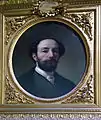 Michele Rapisardi - Self-portrait
Michele Rapisardi - Self-portrait.jpg.webp) Michele Rapisardi - Head of Ofelia pazza
Michele Rapisardi - Head of Ofelia pazza Michele Rapisardi - Study for The Sicilian Vespers
Michele Rapisardi - Study for The Sicilian Vespers Natale Attanasio - Women in the Fields
Natale Attanasio - Women in the Fields Bernardo Celentano - Provenzan Salvani in the piazza del Campo
Bernardo Celentano - Provenzan Salvani in the piazza del Campo
Sala

This houses several 19th century portraits by Rapisarda, Giuseppe Rapisardi, Giuseppe Sciuti, Natale Attanasio, Calcedonio Reina, Francesco Lojacono, Pasquale Liotta, Domenico Morelli, Alessandro Abate, Antonino Gandolfo and Giuseppe Gandolfo, along with a number of 18th century Chinese vases, violins produced by Andrea Amati, Caltagirone ceramics, 17th century bronze statuettes of Venus and Vulcan and an 18th century bronze statuette of Perseus.
.jpg.webp) Antonino Gandolfo - Portrait of La Cognata
Antonino Gandolfo - Portrait of La Cognata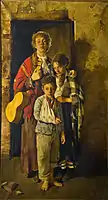 Antonino Gandolfo - Forced Music
Antonino Gandolfo - Forced Music Calcedonio Reina - Love and Death
Calcedonio Reina - Love and Death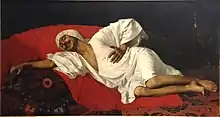 Pasquale Liotta - The Effect of Hashish
Pasquale Liotta - The Effect of Hashish.jpg.webp) Pasquale Liotta - The Incubus of Elizabeth I
Pasquale Liotta - The Incubus of Elizabeth I.jpg.webp) Francesco Lojacono - Fisherman
Francesco Lojacono - Fisherman.jpg.webp) Domenico Morelli - The Death of Tasso
Domenico Morelli - The Death of Tasso.jpg.webp) Girolamo Induno - Woman Cooking
Girolamo Induno - Woman Cooking.jpg.webp) Alessandro Abate - Forced music
Alessandro Abate - Forced music.jpg.webp) Michele Rapisardi - Happy Hours
Michele Rapisardi - Happy Hours.jpg.webp) Michel Rapisardi - Venus on a Green Couch
Michel Rapisardi - Venus on a Green Couch.jpg.webp) Giuseppe Rapisardi - Family Portrait
Giuseppe Rapisardi - Family Portrait_inv_6643_-_Foto_Giovanni_Dall'Orto_2-Oct-2006a.jpg.webp) Perseus (16th century)
Perseus (16th century) Caltagirone ceramic, 18th century
Caltagirone ceramic, 18th century Caltagirone ceramic, 18th century
Caltagirone ceramic, 18th century Caltagirone ceramic, 18th century
Caltagirone ceramic, 18th century
Open Space
This large room houses temporary exhibitions as well as sculptures, bas-reliefs, inscriptions from Certosa di Nuovaluce and an urn by the Gaginian school. A room beside it houses some of the numismatic collection and the whole Fondo Sebastiano Ittar, including engravings by Ittar showing studies of monuments and works of art in Catania.
References
| Wikimedia Commons has media related to Castello Ursino (Catania). |
- Orlando, Andrea. "Castello Ursino O Svevo Di Catania". iCastelli.it (in Italian). Archived from the original on 13 July 2015. Retrieved 24 July 2015.
- Hindley, Geoffrey (1968). Castles of Europe. Great Buildings of the World. Feltham, Middlesex, England: Paul Hamlyn. p. 149. ISBN 978-0-600-01635-9.